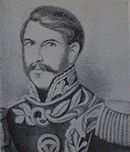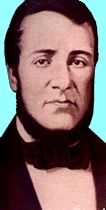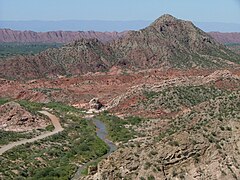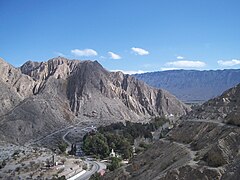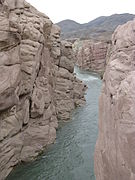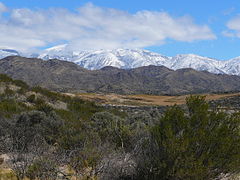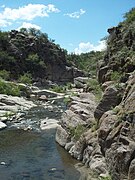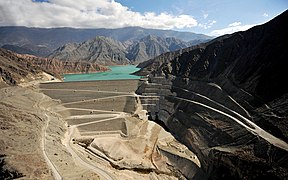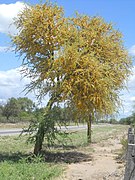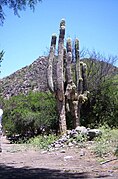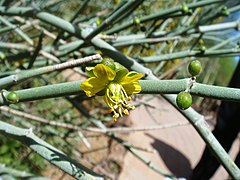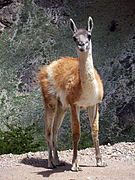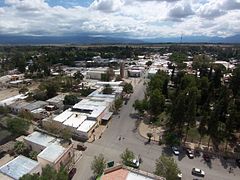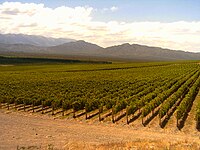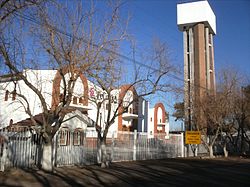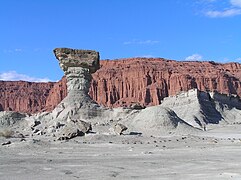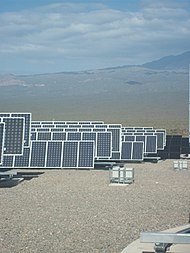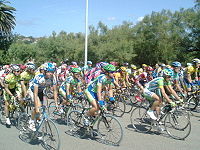Saint John Province
San Juan, in the text of the provincial Constitution: Province of San Juan is one of the twenty-three provinces of the Argentine Republic. In turn, it is one of the twenty-four self-governing states or first-order jurisdictions that make up the country, and one of the twenty-four national legislative electoral districts. Its capital and most populous city is the homonymous San Juan. It is located in the northwest of the Cuyo region and more precisely to the west of the country, bordering La Rioja to the northeast, San Luis to the southeast, Mendoza to the south, and the Chilean regions of Atacama, Coquimbo, and Valparaíso to the west.
With its 681,000 inhabitants (2010 census), it is the thirteenth most populous jurisdiction in the country, and the second most populated province in the Cuyo Region.
The territory of this province covers 89,651 km², slightly larger than Serbia, being the fifteenth largest province, where a mountainous relief interspersed with valleys and traverses prevails under a predominantly dry temperate climate, with a marked scarcity of surface water courses. In the valleys, oasis develop, product of the damming and systematization of the rivers generated by the Andean snowmelt. Among them, the oasis of Tulum stands out, where Gran San Juan is located, an urban nucleus that concentrates more than 60% of the total population of the province.
In the oases, in their spatial development, the agricultural activity stands out, viticulture, an activity that typifies the province. In addition, the olive growing has great prominence; Associated is also a good variety of fruit and vegetables.
From the first two activities, mainly, an agro-industrial complex emerged with the elaboration of wine, being this province the second producer in volume at a national level; possessing in turn outstanding varietal wines. Likewise, large volumes of olive oil are also produced.
In addition to agricultural activity in the oases, there is also a growing and important mining activity.
As far as tourism is concerned, the most important international attractions are mountaineering, with the Mercedario hill and from the scientific point of view Ischigualasto, an important paleontological site of strange geoforms, dating from the Triassic period. Wine tourism has grown considerably in recent years; also adventure sports such as rafting and sand yachting, the latter practiced in a place known as the Pampa del Leoncito, among others. It is also well known for religious tourism, with the much-visited Oratorio de la Difunta Correa.
History
First inhabitants
Before the arrival of the Spanish, this territory was inhabited by various indigenous nations: the Huarpes (to the south), the Diaguitas (to the center and to the north).
The Huarpes inhabited much of what is now known as the Tulum Valley. Its area of influence extended to the Zonda, Ullum, Villicum and Pie de Palo mountains, and the Valdivia hills. Other rooted areas were the influence of the Bermejo River and the Guanacache (or Huanacache) lagoons and both banks of the Desaguadero River. They were engaged in agriculture and livestock. The groups were located on lands irrigated by networks of canals and ditches that they themselves built to ensure irrigation of corn, quinoa, beans, and squash. Corn was then essential in their diet; They ate it roasted or cooked and they also dried it in the sun to obtain chuchoca that they consumed ground. They raised llamas and guanacos for food and transport. They hunted guanacos, ñandúes and other small animals, they kept the meat charqueada (dried by the sun), for a long time. They also collected ñandú eggs and chañar and carob tree fruits.
The Diaguitas of Northwestern Argentina lived in the area of the current departments of Jáchal and Iglesia, to the north of the Huarpe populations. They practiced agriculture with the support of artificial irrigation and cultivated corn that they kept in semi-subterranean granaries. They lived in towns, in adobe houses with roofs made of sticks and grass. The Diaguita people stood out in ceramics: they made wide-mouthed vessels with geometric drawings.
The Diaguitas also inhabited the Bermejo River Valley and Valle Fértil. Historical documentation mentions that these groups were very numerous and lived mainly from llama livestock. They also collected and practiced agriculture. They were also keepers and breeders of cattle in the Spanish ranches. They used the stone for arrowheads, axes, knives, scrapers, beads for necklaces, and pipes.
The Foundation
In the year 1551, Captain Francisco de Villagra toured the area of what is now the provinces of San Juan and Mendoza. From that moment, there were several groups that explored the San Juan territory, sent by the authorities of the General Captaincy of Chile, which was a minor territorial division of the Spanish Empire, which depended on the Viceroyalty of Peru. These previous expeditions made contact with the Huarpe Indians, who received the Spanish peacefully. Precisely the existence of a large number of indigenous people who could be brought to Chile to work in the fields or the mines was one of the reasons why the Spanish decided to take effective possession of these territories.
On June 13, 1562, Juan Jufré de Loayza y Montese founded San Juan de la Frontera, in the Tulum Valley, by order of Francisco de Villagra, Captain General of Chile. The ceremony had few witnesses: the small group of Spaniards who accompanied Jufré and some indigenous people. An act was read, which was signed by some of the expedition members present. The founding act of the city named it San Juan de la Frontera in honor of the patron saint San Juan Bautista and because its territory reached the border with Tucumán. On the same day, Jufré instituted the first Cabildo, named lieutenant corregidor, and distributed among his people the plots of the city and around 1,500 indigenous people in encomiendas.
At the end of 1593 a flood of the San Juan River devastated the precarious city. Luis Jufré y Meneses, fifth son of the founder, moved it 25 blocks south of its old location. He drew the Plaza Mayor in a bare square and around it San Juan began to grow again, which had to endure new floods, plagues and earthquakes.
On June 25, 1751, Juan de Echegaray managed to found the current city of San José de Jáchal, which is today the head town of the Jáchal department. It is currently the nucleus of an important agricultural region of the province.
San Juan was part of the corregimiento of Cuyo with head in the city of Mendoza integrating the Captaincy General of Chile.
Viceroyalty of the Río de la Plata
With the formation of the Viceroyalty of the Río de la Plata in 1777, the Corregimiento de Cuyo was separated from the Government of Chile.
The Royal Ordinance of Mayors of January 28, 1782 divided the Viceroyalty of the Río de la Plata into 8 governorships-intendances, in addition to the military and political governorships of Montevideo and the towns of the old Jesuit Missions, briefly forming the Municipality of Cuyo. But as a consequence of the report presented by Viceroy Juan José de Vértiz, this structure was modified by Royal Order of July 29, 1782 and by the clarifying document of August 5, 1785, suppressing the municipalities of Cuyo and Santa Cruz de la Sierra and dividing that of Tucumán in two, integrating Cuyo the new Governor's Office of Córdoba del Tucumán.
Revolutionary times
On July 7, 1810, an Open Town Hall recognized the First Board of Buenos Aires and elected José Ignacio Fernández Maradona as deputy for the Big Board.
On November 29, 1813, the Intendency of Cuyo Governorate was recreated, separating it from that of Córdoba del Tucumán, made up of the parties, under the command of sub-delegates, of San Luis, Mendoza and San Juan. The first lieutenant governor assigned to Cuyo was Colonel Florencio Terrada, later, Colonel Marcos Balcarce and then José de San Martín were appointed Mayor Governor.
On June 13, 1815, Fray Justo Santa María de Oro was elected as deputy for San Juan for the Congress of Tucumán, and on September 12, Francisco Narciso Laprida was elected as the second deputy for San Juan for the same congress.
In 1819, General San Martín visited the city of San Juan, and slept in a cell at the Santo Domingo Convent.
Provincial autonomy
On January 9, 1820, the uprising of the 1st Regiment of Cazadores de los Andes took place in San Juan, accompanied by a recently created body of dragoons. The leaders of the mutiny were Captains Mariano Mendizábal and Francisco Solano del Corro and Lieutenant Pablo Morcillo. After dominating the resistance of the civics under the command of José Bernardo Navarro, they deposed the lieutenant governor José Ignacio de la Roza and arrested the head of the regiment, lieutenant colonel Severo García de Sequeira. Mendizábal called an open council that named him by acclamation that same day lieutenant governor and commander of arms of San Juan, but he only assumed the military post, leaving political power to the council. On January 10, Mendizábal He sent the Supreme Director, José Rondeau, an extensive note justifying the uprising.
On February 20, the news of the Battle of Cepeda reached San Juan, which had caused the fall of the Directory and the dissolution of the National Government on February 11. An open town hall was convened for February 27 to decide whether San Juan would continue to depend on Mendoza or if it would become another federated province. The assembly failed and another was called for March 1, during which the act declaring the autonomy of San Juan as a new province of the federation was signed. From that moment on, the Province of Cuyo was dissolved and Mariano Mendizábal became the first governor of San Juan.
That the other federated provinces were united in the most solemn manner; that they were obliged to obey and to uphold all the covenants and establishments that sanctioned the legislative authority that constituted the federated provinces; that, once their sovereignty was assumed, the people were declared, independent of that which until here had been the capital of the Province, and that the present ruler was raised by the people to the class of Governor, with all the powers and prerogatives.Part of the record of 1 March 1820
 Wikisource contains original works of or about San Juan Province.
Wikisource contains original works of or about San Juan Province.
When the events in San Juan became known in Mendoza, on March 10 a contingent under the command of General Rudecindo Alvarado departed for that city with two companies of hunters and two pieces of artillery, but upon arriving in Pocito on March 14, he stopped there awaiting favorable events. When no movement against the new authorities took place in San Juan, he returned to Mendoza.
On March 21, Mendizábal was overthrown, later sent to Lima and executed for treason, with José Ignacio Fernández de Maradona temporarily assuming the governorship. On March 23, he signed an agreement with representatives of the new governor of Mendoza, Pedro José Campos, which recognized the autonomy of San Juan. On June 5, 1820, Maradona resigned and was replaced by the Chilean José Antonio Sánchez.
On January 21, 1821, the first Board of Representatives of San Juan was put into office, made up of 9 representatives from the city of San Juan, one from Jáchal and one from Valle Fértil.
After the national organization, the Province of San Juan sanctioned a constitution on April 7, 1856.
In 1861 Juan Saá invaded the province and attacked the weak forces of San Juan in the Battle of Rinconada del Pocito, on January 11, completely defeating them. The same governor, Antonino Aberastain, was in command of his forces and was captured; several prisoners were executed, among them the governor himself, who was shot the next day, by order of Colonel Francisco Clavero.
In 1862, Domingo Faustino Sarmiento took office as governor, managing in just two years to change the physiognomy of the province, opened new paths, founded new schools, encouraged agriculture, created mining projects, promoted settlement with the arrival of the immigrants etc
On December 9, 1869, during the government of Dr. José María del Carril, the Departmental Regime Law was enacted in accordance with article 36 of the Constitution of the Province, where the creation of the Pocito Department was achieved. The Calingasta Department was also created on December 17, and the Angaco department was separated into Angaco Norte and Angaco Sud.
In 1870 the first political division of the province was made into 18 departments, naming them as cities, Desamparados, Concepción, Trinidad, Santa Lucía, Pocito, Marquesado, Albardón, Angaco Norte (current Angaco), Angaco Sud (current San Martín) , San Isidro, Caucete, La Huerta, Valle Fértil, Jáchal, Iglesia, Gualilán, Calingasta, Guanacache and Pedernal
On December 26, 1882, the Department of May 25 was created.
In 1884 Sarmiento made his last visit to San Juan. The people turned to the streets to see the man from San Juan who became President of the Nation. He stayed a few days in the province and attended as a special guest the inauguration of the government house of this province, where he gave a speech.
By 1887, the province of San Juan had a population of 102,000 inhabitants, 85,214 hectares cultivated with artificial irrigation, through canals, of which only 3,634 were vineyards.
20th century
In 1908, under the governorship of Colonel Carlos Sarmiento, a law was enacted on August 25, which designated the area of the current departments of Rivadavia, Zonda and Ullum, with the name of Rivadavia, to honor the former president. Also on the same day and year, the Sarmiento department is created, suppressing the old jurisdictions of Guanacache and Pedernal, to later be districts
In 1928, a new Municipal Regime law was enacted, it said that it included the Rivadavia area within the Capital department.
In 1931, Federico Cantoni won the elections. The railway to the Department of Jáchal was inaugurated.
In 1935, the area called Rivadavia was separated from the Capital department and from Rivadavia the area called Zonda to begin to definitively form a new department. Valle Fértil is also recognized as an independent department and the current limits are established.
In 1936, the bridges over the San Juan River were inaugurated, connecting the departments of Caucete, Albardón and Calingasta, built with iron brought from Europe.
In 1940, the first report on the importance of Ischigualasto was presented. The first works of industrial production of olive oil begin to be visualized.
On September 9, 1942, the Rawson department was created by law, being Villa Krause, the head. Also on September 19, the department of Rivadavia was definitively created, setting the current limits and the department of July 9 was also created, for having been separated from Pocito. The old Angaco Sur Department changed its name to the current San Martín department and by the municipal organic law of September 4, the definitive limits of the Zonda department were set, with the main town being Villa Basilio Nievas on a small urban center that reminds one of the first settlers.
In 1944, there was an earthquake that reached a magnitude of 7.8 on the Richter scale and a maximum intensity of IX on the modified Mercalli scale. The epicenter was located 20 km north of the city of San Juan, in the vicinity of the town of La Laja, in the department of Albardón. This earthquake on January 15 was the greatest tragedy that the Argentine people can remember. There is talk of 10,000 deaths, an even higher number of wounded, the almost total destruction of a city.
On June 25, 1966, the provinces of San Juan and Mendoza signed an Interprovincial Boundary Agreement, which delimited the entire border between the two provinces. The limit was set by National Law No. 22200 issued by the military government and published in the Official Gazette on March 27, 1980.
Decree-Law No. 18,004 promulgated by the military government on December 23, 1968, established the limits between the provinces of La Rioja and San Juan. Previously, the military controllers of both provinces entered into an agreement on March 12, 1968, in order to put an end to a secular boundary dispute. On December 21, 1973, the Legislature of La Rioja sanctioned Provincial Law No. 3,468, ignoring the validity of the Decree-Law of the military government. The government of San Juan sanctioned Provincial Law No. 3,580 in January 1969, ratifying the interprovincial agreement signed by the military inspectors in 1968. The dispute centers on the glacier and El Potro hill —with copper mining potential and gold—, where Decree-Law No. 18,004 establishes that the limit starts from El Potro hill, going from there in a southeasterly direction until reaching the Blanco River, but it does not say what the angle of the southeast direction is, so the area is delimited but not demarcated.
1972, the first National Sun Festival was organized.
In 1973, the National University of San Juan was created.
On November 23, 1977, at 6:25 a.m., San Juan was once again shaken by telluric forces. An earthquake measuring 9 on the Mercalli scale or 7.4 on the Richter scale had the Sierra de Pie de Palo as its epicenter and affected the departments of Caucete, May 25, July 9, San Martín and Angaco. The long-lasting earthquake was felt throughout the country, which caused 65 deaths and more than 300 injuries, destroying many buildings —almost all built without respecting anti-seismic regulations— in the city of Caucete and seriously affecting the agricultural activity of the eastern zone of the Tulum Valley.
In 1980, the Ullum Reservoir hydroelectric project was finally inaugurated. Broadly benefiting agriculture, causing a growing increase in cultivated area.
In 1984, the Rawson department was declared a city, with a seat in Villa Krause. Being today one of the most important cities of Greater San Juan, where intense commercial activity takes place.
In 1994, passenger trains stopped running for good.
In 1998, the hydroelectric works of the Caracoles Dam began.
21st century
In 2001, the problems in the administration worsened due to wage arrears. Some deputies resign. There are mobilizations throughout the province, promoted by different state unions. Banks do not refund time deposits.
In 2003, José Luis Gioja triumphed in the elections as governor.
In 2005, mining began to develop considerably, causing an important change in the local economy and also the rejection of this activity in important sectors of the population due to the serious environmental consequences that it could cause. The multinational company Barrick was in charge of the exploitation in the high mountains, with projects such as Pascua Lama and Veladero, where today various metals are extracted, especially gold.
Starting in 2007, oil search work began in the province, a more than positive change for the local economy is estimated. Under a new initiative, with new artistic stages and a carousel through the city of San Juan, the National Sun Festival is held.
In 2008, the filling of the Caracoles reservoir began.
In 2014, several departments of the province were affected by floods as a result of the fall, for three consecutive days, of 136 mm of rainfall above the annual average.
San Juan and the crossing of the Andes
General San Martín led the bulk of the army through the province of San Juan, through the Paso de Los Patos, Calingasta; however, much of the artillery had to be led through the Paso de Uspallata. During 1815 and 1816 the Crossing of the Andes was carried out, San Juan undertook through its Cabildo to form a battalion of 500 soldiers. For this, the voluntary and compulsory recruitment of men was ordered. However, the bulk of what would be the Northern Division, under the command of Lieutenant Colonel Juan Manuel Cabot, was made up of volunteers who were joining the passage of the column through the San Juan territory. The expedition carried more than 1,500 animals and weapons.
In addition, San Juan provided officers and soldiers, militiamen and muleteers, gunpowder and food. At the request of General San Martín, in San Juan the Lieutenant Governor José Ignacio de la Roza implemented taxes on wines and spirits that were sold outside the province in order to raise funds.
The women from San Juan were in charge of weaving cloth, donating jewelry and objects made of carved silver, while everyone who could gave money, caravans, brandy and wine, raisins, flour, wheat, corn, soap, olives, horse mules saddle and load, horses, bovine hides, saddles, ponchos, barrels, the entire existence of tin and even black slaves. The neighborhood gave up everything it owned and was subjected to an extraordinary contribution, while the Convent of Santo Domingo was ceded as a headquarters for the troops.
The province of San Juan, together with the contribution and passage of General José de San Martín through said province, owes itself and in homage to such a feat, a monument that honors General José de San Martín on his Libertador passage through said territory.
Government and politics
The Province of San Juan is, like the other Argentine provinces, autonomous from the national government in most matters, except those of federal scope. This is recognized by article 121 of the Constitution of the Argentine Nation:
The provinces retain all the power not delegated by this Constitution to the federal government, and those expressly reserved for special acts while incorporating them.
As a pre-existing State of the Nation, the province has its own Constitution. The first was drafted in 1854 and reformed in 1868. A new Constitution was issued in 1873, with reforms discussed in the convention that met between 1862 and 1889. Then the Constitution of 1927 was sanctioned, which introduced the female vote decades earlier to the national regime. The current Provincial Constitution dates back to 1986. In 2011 a reform was carried out that modified article 175 of the Provincial Constitution, which established a single re-election limit for the president. The text approved yesterday states that the governor and the lieutenant governor "can be re-elected consecutively up to two times", through the procedure provided for therein (third section Reform of the constitution art 271-278).
Government authorities are headquartered in the city of San Juan, which is the provincial capital.
Executive Branch
The executive power is unipersonal and rests with a citizen, directly elected by the citizens, men and women, with the capacity to be voters and who are registered in the civic registry of the province, for the position of Governor. in charge of executing the laws and administering the provincial budget, with the collaboration of his cabinet of ministers. He is elected together with the Lieutenant Governor, who in turn is president of the Chamber of Provincial Senators. The security forces of the Police of the Province of San Juan depend on the Executive. The Constitution of the Province establishes a government period of 4 years, and does not allow the re-election of the Governor without allowing an intermediate period to pass. Said restriction extends to relatives up to the second degree of consanguinity.
Legislative branch
According to article 131 of the provincial constitution, the Legislative Power of the Province is exercised by a Chamber of Deputies made up of one representative from each of the departments into which the Province is divided, in accordance with the provisions of said Constitution. Each department is considered as a single electoral district for the election of its representative by simple majority of votes. It is also made up of one deputy for every twenty thousand inhabitants elected by the proportional representation system, taking the Province as the sole electoral district. The law can increase but not decrease the base of representation determined for each deputy elected by the proportional system. .
In article 145.º, the lieutenant governor of the province is designated as ex officio President of the Chamber of Deputies, but he does not have a vote, except in cases of a tie. The chamber appoints annually, in its first ordinary session, a first vice-president and a second vice-president from among its members, who, when they hold the presidency of the chamber, will have a vote and will decide in the event of a tie.
Article 132 of said constitution establishes: the deputies will last four years in their functions, begin and end their terms at the same time that the Executive Branch does, and can be reelected.
Judicial branch
According to the provisions of Article 179 of the Provincial Constitution, the Judicial Power of the Province is carried out by a Court of Justice, Chambers, Judges and Justices of the Peace, Lawyers and other courts established by law. At the same time, citing article 198, it has all the power necessary to maintain its inviolability and independence before the other powers of the State.
In article 201, it is mentioned that the Court of Justice is made up of at least five members, and is divided into rooms; Only by law can the number be increased, which must always be odd. The Presidency of the body is performed annually and in turn, by each of its members, beginning with the oldest.
Article 213 provides that the Judiciary has the necessary public force to carry out its functions. The Court of Justice organizes the Judicial Police, in accordance with the provisions of said Constitution and the law; This Police is your exclusive dependency.
The Trial Jury is made up of a member of the Court of Justice appointed by lottery by it; two deputies elected by the Chamber and two lawyers from the registration elected in the same way as those who make up the Council of the Magistracy and who meet the conditions to be members of the Court, sufficiently in advance so that they are in conditions to be constituted as of the first day of January of each year, established in article 230.º.
Ministries and Secretariats
Article 191 of the Constitution of San Juan establishes that the office of administrative business of the Province is in charge of the Ministers appointed by the Governor, whose number will not be less than five. A law whose initiative is exclusive to the Executive Power, will determine the number, branch and functions.
Article 195 ratifies that the Minister (in charge of the ministry) endorses and legalizes the Governor's resolutions with his signature, without which they will have no effect or compliance. He is thus jointly and severally responsible for the acts that he performs with the Governor. He can only decide by himself regarding internal and disciplinary matters in their respective departments and issue orders for procedures. He is responsible for all the resolutions and orders that he authorizes and jointly and severally for what he resolves with his peers, without him being able to exempt himself from responsibility for having acted by virtue of the Governor's orders.
The government of San Juan has the following ministries:
- Ministry of Human Development and Social Promotion
- Ministry of Education
- Ministry of Government
- Ministry of Finance and Finance
- Ministry of Mining
- Ministry of Infrastructure and Public Services
- Ministry of Production and Economic Development
- Ministry of Health
- Ministry of Tourism and Culture
- Environment and sustainable development secretariat
- Ministry of Science, Technology and Innovation
- Sports secretariat
- General Secretariat of the Government
Municipal governments
Article 239 of the Provincial Constitution establishes that any population center with more than two thousand inhabitants within the ejido (province), can constitute a municipality, which will be governed by a mayor, whose requirements to be so are established by said constitution, municipal charters and the Organic Law that the Executive Power dictates as a consequence.
According to what is written in article 240, the municipalities will be of three categories; namely:
- The municipalities of “first category”: the cities of more than thirty thousand (30 000) inhabitants;
- The “second category” municipalities: the cities of more than ten thousand (10 000) inhabitants.
- The “third category” municipalities: the cities, villas or towns of more than two thousand (2000).
The official national or provincial censuses legally carried out will determine the category of each municipality.
Territorial organization
The province is divided into 19 departments. The Constitution that governs the province was sanctioned in 1986. In San Juan, departments and municipalities correspond to the same entity, these go back to the councils, which marked the institutional life of America when it was under Spanish rule, after the May Revolution they began to disappear and in San Juan they ceased to exist in 1821.
In 1824, Governor Martín Yanzón organized the territory of this province into two departments, the "department of the North" and the "department of the South& #34;, with three neighborhoods each. Later, an irrigation regiment of 1851 divided San Juan into territorial sections, each run by an irrigation board.
The first provincial constitution of 1856 provided for an organization in departments and these in districts; but in 1909 the limits, headers and their respective names were more precisely established. Later laws made modifications in this matter, but until 1942 the current layout was not defined in 19 departments.
| Department | Main location | Surface | Population (2010) |
| Albardón | General San Martín | 915 km2 | 23,888. |
| Angaco | Villa El Salvador | 1.865 km2 | 8,125 hab. |
| Calingasta | Tamaria | 22,589 km2 | 8,588 hab. |
| Capital | San Juan | 30 km2 | 109.123 hab. |
| Caucete | Caucete | 7.502 km2 | 38.343 hab. |
| Chimbas | Villa Paula Albarracín de Sarmiento | 62 km2 | 87,258 hab. |
| Church | Rodeo | 19,801 km2 | 9,099. |
| Jáchal | San José de Jáchal | 14.749 km2 | 21,730 hectares. |
| 9 July | 9 July | 185 km2 | 9.307. |
| Pocito | Aberastain | 515 km2 | 53.162. |
| Rawson | Villa Krause | 300 km2 | 114.368 hab. |
| Rivadavia | Rivadavia | 157 km2 | 82,641. |
| San Martín | San Martín | 435 km2 | 11.115 hab. |
| Saint Lucia | Saint Lucia | 45 km2 | 48,087 people. |
| Sarmiento | Media | 2.782 km2 | 22,131 hab. |
| Ullum | Villa Ibáñez | 4.391 km2 | 4.886. |
| Valley | San Agustín | 6.419 km2 | 7.222 hab. |
| 25 May | Santa Rosa | 4.519 km2 | 17.119 hab. |
| Zonda | Villa Basilio Nievas | 4.391 km2 | 4.863 hab. |
To obtain more detailed data regarding the municipalities, see:
- Annex:Municipios de San Juan
- Annex:Distrites of the Province of San Juan
- Annex:Departments of San Juan by surface
For information on the municipal organization of the province, see:
- Municipal Organization of San Juan
Geography
In the territory of the Province of San Juan, it administratively covers 89,651 km²; 80% of the surface is occupied by important mountainous bodies, only 21,000 km² constitute the space available for human occupation; It is made up of valleys and sedimentary pockets originated and modeled by dynamic cycles of water activity and tectonic activity respectively. The climatic restrictions typical of a temperate and semi-arid zone and the distribution of the hydrographic network in three basins, reduces the possibilities of installation and consequently, the useful available area is much less (approximately 170,000 ha) than is available near three rivers.: to the north the Jáchal and to the center-south the San Juan, whose basins have historically been used to organize irrigation systems that feed these areas recognized with the term oasis.
Location
The province of San Juan is located in the south of the continent, America, forming part of the country, Argentina, in the center west of said territory, in the eastern part of the Andes Mountains.
Its limits are determined naturally, by mountain ranges and a river or in some opportunities artificially, by parallels and meridians. Its extreme points are:
- At the northern end is at the El Potro hill on the border with Chile (28°23′00′S 69°40′00′′ / -28.38333, -69.66667)
- The eastern end is located in the Pampa de las Salinas where the boundaries of the province of La Rioja and San Luis converge.31°53′00′S 66°43′00′′ / -31.88333, -66.71667
- To the south the end point is near the Portillo del Cuerno.32°37′00′S 70°04′00′′ / -32.61667, -70.06667
- To the western end is to the southwest of the Pass of the Piuquenes on the border with Chile. 31°29′00′′S 70°35′00′′ / -31.48333, -70.58333
Relief of Saint John
In the province of San Juan to the west runs the Cordillera de los Andes, which comprises three sections: The Main Cordillera or Occidental, watershed and border with Chile, presents eternal snow from 5,500 meters above sea level. no. m. and mountain passes only passable in summer. The highest peak is the Cerro Mercedario at 6,770 m s. no. m.. The Frontal Cordillera or Eastern Cordillera, less elevated than the first, is made up of numerous independent cordilleras such as San Guillermo, Colangüil and Ansilta.
This mountainous mass in the west of the province contains glaciers and winter snows that facilitate the accumulation of hydrological assets; This accumulated mass is recovered through a dense water network characterized by irregular flows (spring and summer) that flow towards the lowlands and are concentrated in valleys and foothill oases.
The Precordillera, separated from the Frontal Cordillera by the Valles Altos (Llanos de San Guillermo, Valle de Iglesia, Pampa de los Avestrues, Valle de Calingasta and Pampa del Leoncito), constitutes a barrier that only the Jáchal and San Juan rivers manage to cross. It includes several discontinuous ranges with heights greater than 4,000 meters, among which the Punilla, Volcán, Negra, La Invernada and Tontal mountain ranges stand out. The foothills area is one of the places in the country with the highest frequency of seismic movements.
To the east of the Precordillera are the Lower Valleys (Jáchal, Ullum, Zonda and Tulúm, all of them converted into large oases irrigated by permanent rivers with low flow, which is why they must be dammed for the construction of artificial canals), separated from the Travesías Cuyanas by isolated mountain ranges such as the Chica de Zonda, Marquesado, Villicum and Mogna sierras, among others.
To the east of the province are the so-called Travesías Cuyanas, vast plains with almost no surface water and sandy areas only interrupted by xerophytic vegetation. They are geological depressions filled with sediments from the Andes, crossed by the Bermejo, Jáchal and San Juan rivers and in which isolated mountain ranges belonging to the Sierras Pampeanas system emerge: the Sierras del Valle Fértil, de la Huerta and de Pie of Palo.
Seismicity
The seismicity of the Cuyo area (central west of Argentina) is frequent and of high intensity with a seismic silence of medium to severe earthquakes every 20 years.
The Caucete earthquake of 1977 left 65 dead, 284 injured and more than 40,000 homeless due to significant material damage to buildings. This earthquake measured 7.4 on the Richter scale. The Civil Defense Day was assigned by decree in memory of the victims of the earthquake.
No records of ground faults were left, and the most notable effect of the earthquake was the large area of liquefaction (possibly thousands of square kilometers). The most dramatic effect of the liquefaction was observed in the city, 70 kilometers from the epicenter: large amounts of sand were seen in fissures up to one meter wide and more than two meters deep. In some of the houses on these fissures, the ground was covered with more than one decimeter of sand.
Although said geological activity has occurred since prehistoric times, the earthquake of March 20, 1861 in Mendoza marked an important milestone in the history of Argentine seismic events since it was the strongest recorded and documented in the country. From there, the policy of the successive provincial and municipal governments of San Juan have been taking extreme care and restricting construction codes. state of the seismic gravity of the region.
Climate
San Juan has a highly continental climate, that is, it has no oceanic influence, it is dry and has little rainfall. Climate influences modeling systems, fluvial regimes, soil types and plant formations. For example, the snow-like precipitations occur in the high mountains and the liquid ones in the rest of the territory.
The areas of the foothills, the "travesías" and Sierras Pampeanas in San Juan, generally have an arid climate of mountains and fields, with irrigation oases. The Valle de los Patos Superior is the only region of South America in which type D continental climates are present. It is the only area in the southern hemisphere with a proper continental climate, with characteristics of mild summer and cold winter (Dsb), according to the Köppen climate classification.
San Juan is characterized by an important annual and daily thermal amplitude, which is the highest in Argentina. In winter the minimum temperatures can reach -5 °C and in summer the maximum exceeds 40 °C. In the Province of San Juan, a temperature of -39.0 °C was recorded on July 17, 1972, at the Valle de los Patos Superior weather station, at 2,880 meters above sea level. This is the lowest official temperature recorded in Argentina (excluding the Antarctic bases) and also in Latin America.
A particularity of the province is the presence of a local wind, the Zonda. This is a very hot and dry wind that blows from the west. This is hot and dry due to the "Föhn effect", exacerbated by adiabasis- that it suffers when crossing the high Andes mountain ranges (some of the highest peaks in the Western Hemisphere are found in the Province).
Water resources
The San Juan river basin, is the main source of water resources for the province, it is located in the central-southwestern sector, crossing the interprovincial limit and covering a small sector in the north of Mendoza. It has an approximate area of 38,462 km², occupies around 45% of the area of the province of San Juan. The San Juan River, the main source of surface water in the basin, flows from west to east and rises at the confluence of the Castaño rivers, to the north, and Los Patos, to the south; which drains an extensive cordilleran front between 30º30'S and 30º40'S. This basin irrigates the largest area of useful hectares: almost 75% in the Tulum Valley (Gran San Juan area of influence), 4.5% in the Calingasta Valley and 3.5% in Ullum-Zonda.
The subterranean water resources of the San Juan territory, which, being located in a mountainous area influenced by Andean tectonism, most of it is located in aquifers that are located in valleys, forming groundwater basins. These basins are separated by mountain ranges made up almost entirely of consolidated, impermeable rocks with very low and high permeability, which are called "basement" of the basin Most of the province's groundwater basins have formed where there are extensive accumulations of Quaternary sediments with permeable intervals.
In the extreme southeast, are the Guanacache (or Huanacache) lagoons, where the San Juan River flows into, one of the most important water resources in the Cuyo geographic region due to its wealth of flora and fauna.
On the other hand, the Huaco river, in the Jáchal department, and the Valle Fértil river, in the department that bears the same name, are also of great importance for the people of San Juan. The province also has several streams that are steep mountain courses. Among the most important are the Agua Negra stream, the Agua Blanca stream, the Iglesia stream, the Ojos de Agua stream, Las Hornillas and the Los Tapones stream, among others. Important works that allow the damming of rivers are also highlighted, such as:
| Dam | Use | Department |
|---|---|---|
| Caracoles | Irrigation and power generation | |
| Seat of the Wind | Tourism and energy generation | Church |
| Ullum | Irrigation, tourism and energy generation | Ullum - Zonda |
| Black tip | Irrigation, tourism and energy generation | Ullum - Zonda |
| San Agustín | Rigo | Valley |
Flora
The province presents a high aridity where the precipitations are completely scarce and a great daily and seasonal thermal amplitude. This extreme aridity is interrupted by the oases or valleys, formed on the banks of the rivers that are born in the Andean glaciers.
The xerophytic vegetation is the most common, standing out the tree stratum: carob tree, chañar; shrub layer: jarillas, chilca, alpataco, retamo. Marsh vegetation such as: reed, reed. In herbaceous: jonquil, in basketry and more crafts.
Wildlife
The fauna is distributed according to the height and the vegetation present in a certain area, since this is the basis of their diet.
Some of the species that make up the general fauna of this province are highly prized by poachers who decimate the communities and turn the animals into endangered species. One of the most threatened in the province of San Juan is the vicuña, persecuted for its wool. The iguana, the condor, the red fox and land turtles are also in danger. This is the case for which this province provides protection to the vicuña, which is an animal that is in danger of extinction, in the region, for this there is the San Guillermo National Park, which was declared by Unesco as a Biosphere Reserve.
San Juan presents a fauna that is represented by a great variety of Andean, Patagonian and Pampean species. Mammals found in the province are: guanaco, vicuña, fox, puma, European hare, mara, vizcacha, weasel, quirquincho, ferret, peccary, coypu, large chinchilla and armadillos. Trout, silverside, catfish and carp are some of the fish that live in rivers.
San Juan, in 2009, had 15 protected areas that occupy more than 22% of the total territory. A fact that begins to take value when it is known that it is the province with the largest area covered by special conservation regulations, and that many of these areas are unique in the continent (America) and in the world for their paleontological or wild value.
Protected natural areas
The province of San Juan administers and manages a set of protected areas with various objectives, surfaces and degrees of control.
| Protected area | Department | Surface |
|---|---|---|
| Ischigualasto (or La Luna Valley) | Valley | 62 916 ha. |
| Valley | Valley Jáchal Caucete | 800 000 ha. |
| San Guillermo | Church | 811 460 ha. |
| Parque Sarmiento | Zonda | 748 ha. |
| Ullum Quebrada reservoir | Ullum | 7212 ha. |
| Cerro Alcázar | Calingasta | 1000 ha |
| Don Carmelo Reserve | Ullum | 35 000 ha. |
| The Morrillos | Calingasta | 23 500 ha. |
| Pedernal | Sarmiento | 17 700 ha. |
| Loma de Las Tapias | Ullum Albardón | 5000 ha. |
| Limo Arcilloso | Ullum | 1200 ha. |
| The Ciénaga | Jáchal | 9600 ha. |
Population
The 2010 national census established a population of 681,055. The 2001 Census indicated that San Juan had 622,094 inhabitants (Indec, 2001), with the majority being the urban population with 528,267 inhabitants (Indec, 2001) and the minority rural population: 93,827 inhabitants (Indec, 2001). For the 1991 Census, said province had 528,715 inhabitants (Indec, 1991), with an urban population of: 424,416 inhabitants (Indec, 1991) and a rural population of: 44,663 inhabitants (Indec, 1991).
It is estimated that 70% of San Juan residents are of European descent, of which the majority are of Spanish descent, followed by a minority of Italian descendants and finally, small minorities of descendants of other European ethnic groups. They are especially concentrated in the provincial capital. There are also important communities of descendants of immigrants from the Middle East, especially Syrians and Lebanese.
Indigenous descendants make up the second majority, most of whom have Huarpe ancestry. They are mainly concentrated in the departments of Iglesia, Calingasta, Zonda and Angaco.
Despite the inter-census increase, an exodus trend is observed, the 1991 census reveals the 2001 census, 9 out of 100 San Juan residents left, which is equivalent to 27% of the total population who left the province, coming to occupy the 2nd place among the provinces with the most population exodus, being only surpassed by Santiago del Estero.
Distribution
The population is grouped and its presence is dense in those departments where there is the possibility of having water. Density outside these areas is very low. The majority of its population is concentrated in the oases or central valleys, that is to say: Tulum, Ullum, Zonda, and Jáchal, containing approximately 90% of the total population. In minority, the rest of that percentage is located in the valleys of Iglesia and Calingasta, where small towns dedicated mainly to agriculture and tourism in recent times can be seen. Another concentration is found in Valle Fértil, in a loosely organized way in small dispersed towns.
The main cities of the province are found in Greater San Juan, concentrating this to San Juan, the provincial capital, administrative, commercial center and seat of government authorities of the province, to Villa Krause, the main commercial nucleus of the southern zone of Greater San Juan. From this point of view, said cities do not exist as units, but form a single agglomerated mass, Greater San Juan. Caucete, the administrative and commercial center of the eastern area of the Tulum Valley, is the only major city after the aforementioned agglomerate. The towns General San Martín, Aberastain and San José de Jáchal also stand out, the latter being the main urban center in the north of San Juan
Demographic evolution
| Statistics | |
|---|---|
| Historical developments in the San Juan province from 1778 to 2010 | |
| Years | Population (hab.) |
| 1778 | 7.690 |
| 1820 | 25,000 |
| 1847 | 25,000 |
| 1853 | 45,000 |
| 1869 | 60.319 |
| 1895 | 84.450 |
| 1914 | 119.252 |
| 1947 | 262.229 |
| 1960 | 352.287 |
| 1970 | 384.284 |
| 1980 | 465.976 |
| 1991 | 528.715 |
| 2001 | 622.094 |
| 2010 | 681.055 |
In general it can be said that although San Juan shows a very slow evolution of the population until the beginning of the XXI century, periods with differentiated growths can be observed. In that context you can mark:
- the arrival of the Ferrocarril stimulated demographic movements in the province between 1914 and 1947, a period of 2 %.
- The figures show a progressive loss from there on, particularly in the 1970s when it begins to behave as a population-expulsive centre.
- In the following decade the province partially recovers its rate of growth (19.4 %) which although moderate is somewhat higher than the national average.
- The 2001 Census marks a new decline in the rate of growth (although it is always maintained above the national average), a greater increase in population in absolute terms in the Valley of the Tulum and a retraction marked above all in the peripheral oasis: Church-Rodeo, Calingasta-Barreal, Jáchal-Huaco and Valle Fértil. Growth is concentrated in Tulum-Ullúm-Zonda and demographic decline in the small towns of the edges of the oasis and the secano.
For more information, see
- Annex:Departments of San Juan by population
- Annex:Departments of San Juan by population (cense 2010)
- Annex: Simple and composite locations in the province of San Juan
- Annex: Headquarters by population
According to the 2010 census, the province has a rural population of 87,672 people.
| Graphic of demographic evolution of San Juan between 1869 and |
 |
Economy
The economy of the province of San Juan is represented by agriculture, where vine cultivation stands out. In the industry stands out the production of wine and various food preserves. Mining has also begun to develop intensely, with the extraction of various minerals, hand in hand with various multinational companies, and tourism. By the beginning of 2010, mainly as a result of mining, San Juan went from exporting 15 to 38% of what it produces, although this implies ecological problems and the health of the population close to these enterprises, which in the future could get worse.
Taking into account a geoeconomic point of view, the province presents a spatial aspect of low economic profitability, since it lacks in quantity and quality of resources: soil (since the presence of rocky outcrop predominates) and water (shortage of rainfall, since they do not generally exceed 100 mm and scarcity of permanent river courses at surface level). These aspects are one of the most preponderant causes of the morphology of economic spaces characterized by a system of intensive agriculture supported by artificial irrigation, with the predominant presence of smallholdings and with little development in livestock activity. However, the significant presence of outcrop rock may allow the operation of the mining activity, but water scarcity would be a negative factor for it. The majority of the economically active population is concentrated in the urban agglomeration of Greater San Juan, where a secondary, tertiary and quaternary activity is carried out.
Exports
Exports from the province of San Juan totaled 1,206 million dollars in the course of 2021 (32.9% of the total foreign sales of the Cuyo region), which represented an increase of 7.7% compared to to 2020. Among the most relevant products of provincial exports, we can mention vegetable, legume and fruit preparations (5.0%) -in particular, fruit and vegetable juices-, which decreased their shipments 10.4% in the period; and chemical and related products, which accounted for 4.1% of shipments abroad. Another important item was dried or processed fruits, which represented 3.8% of total exports from this province, with a year-on-year rise of 2.3%. The behavior of unprocessed vegetables and legumes also stood out, with 3.1% of total exports and whose dispatches fell 14.0% in the period: mainly due to lower sales of garlic and onions that suffered falls of 16.7 % and 20.0% respectively, in relation to the previous year. The bulk of exports were concentrated in four main destinations: Switzerland, USMCA and Mercosur. Shipments to Chile and the European Union were also highlighted.
Primary Activities
Agriculture and livestock
Agriculture in San Juan is represented by the cultivation of the vine. Being the second producer of Argentine wine, standing out in the variety of Syrah and Malbec.
The vine arrived in San Juan between 1569 and 1589 at the hands of Spanish conquerors. Favored by optimal climatic and soil conditions, viticulture showed a broad and accelerated development in this province. At the beginning, it was produced in a reduced volume, limited to satisfying the needs of the small communities in the colony. Various difficulties had to be faced, on the one hand the aridity of the climate forced the construction of dikes and artificial irrigation systems (canals) and on the other hand the competition of higher quality products from Europe.
San Juan is the second in terms of cultivated area per vine in the country, since it represents 21.69% of the total in hectares planted throughout the country. From a geographical point of view, the largest production is located in the area of the agricultural oases of Tulum, Ullum and Zonda, where it represents a large part of the productive area, although it is possible to mention the development seen in recent times in the Calingasta Valley.
Olive cultivation also stands out, where some 2,000 new hectares were added in 2006, and 1,800 are expected to be added in 2009 in the Cañada Honda area (more than 1,300 hectares would be planted), to the south of the town de Retamito, (they will soon add 250 ha) in the Sarmiento department and near the town of Encón, in the 25 de mayo department (more than 100 ha would be planted); always destined to produce olives in canneries and oil.
In San Juan there is an important number of fruit trees (peach, tomato, quince, apple, grape, melon, watermelon, etc.) and vegetables with important onion plantations in the Jáchal Valley and garlic in the Calingasta Valley, asparagus and squash, among others, also stand out.
For the benefit of this activity, the construction of the Caracoles reservoir, one of the most important hydroelectric projects in Argentina, has been completed. This mega work will allow the addition of some 17,000 ha of irrigated crop plantations to the agricultural oasis of the Tulum Valley.
Also by the beginning of 2010, the renovation works carried out in the Canal del Norte, the main irrigation canal of the province that allows the development of the production of grapes for winemaking, raisins, musts and fresh consumption, will be completed; olive trees for canning and oil, and various horticultural crops.
- Annex: Water infrastructure of the province of San Juan
As in the rest of the Cuyo region, in San Juan, livestock farming is not very significant, nor does it represent much interest. Currently, the Cuyo region only contributes 4% of the national production in terms of livestock. The most relevant production in this province is that of goats and, among exports, dairy farms that specialize in the breeding and exploitation of cattle are important. to obtain milk. Pig farming is also very prominent.
Mining
San Juan is a province in which a large part of the territory is occupied by a mountainous relief, which led various mining companies from various mining countries such as Canada to settle in the province. It is rich in metalliferous and non-metalliferous resources and application rocks. Mining economically occupies 58.4% of the monetary income in San Juan.
The location of the mining resources is in three large regions:
- Western Region of San Juan "Cordillera Frontal y Principal": a region with more than 37,000 km2 with good road infrastructure, where it is possible to extract minerals such as gold, copper, lead, silver, zinc, molybdenum, arsenic, bias and others, resources in industrial minerals and applied rocks such as sulfate aluminum, plaster, granite, riolita and others.
- "Precordillera" Central Region: This region is where the largest extractive mining activity takes place in the province represented by the production of industrial minerals and application rock. They are more than 23 000 km2 with good road infrastructure. A favorable geological environment for base and precious metal mineralizations. Imponent potential in industrial minerals and applied rocks such as limestone, dolomite, diatomite, bentonite, caolin, gravel, sodium sulfate, travertine, marble and schist.
- Eastern Region "Sierras Pampeanas": This area has more than 16 000 km2 of promisory geological environment for precious and base metals. Well-known ore mineralization systems. Potentiality in industrial minerals and applied rocks such as marbles and schist, pegmatite minerals and rare minerals.
At the beginning of the 2000s the province entered an important mining development. Traditionally this activity was carried out by small and medium-sized local companies; currently, mineral extraction is in the hands of large multinational companies, which perform various tasks.
The first project launched was the so-called Veladero, one of the most important in the country, from which in less than 1 year more than 11,000 ounces of gold have been extracted and between From 2005 to 2007, 23.1% of the province's Gross Geographic Product (PBG), that is, almost a quarter of all the economic activity produced that year, was represented by this mining project. Other figures indicate that Veladero in relation to the industrial sector, indicate that in 2007 San Juan's industrial exports totaled 457 million dollars, against 56 million dollars in 2003. This allowed the province to go from occupying position 13 in the national classification table of industrial exports, with respect to the other provinces, in 2003, to be ranked 5th in 2008, with a sustained growth projection for the year 2010.
But more projects stand out, including this one, Gualcamayo, located in the department of Jáchal, which at the beginning of 2009 obtained its first 99% pure gold ingot, and that on May 7, 2009 the mine had already reached 60% of its production capacity, starting its definitive activities on September 30, 2009, this project is expected to produce 150,000 ounces of gold per year, and after the 10-year useful life expected for the metal mining, there is the possibility, and continue to exploit lime industrially.
Another is Pascua Lama, with the particularity that it will be shared with the neighboring country of Chile, as it is one of the most important projects in the world. Also, which is currently in the feasibility evaluation process, is the project Pachón, located in Calingasta, which by 2008 had made significant progress in relation to its infrastructure development.
San Juan is one of the provinces with the greatest capacity for exploring the country. It has achieved significant development in the production of industrial, natural and processed minerals, such as limestone, dolomite, gypsum, quartz, bentonite, feldspar, marble, flagstone, cement, calcium carbonate and calcium carbide, standing out in extraction and production of lime and gold.
Accompanied by the development and promotion by the government of said province, came the conflict related to the environmental impact experienced by this activity. Causing a strong gap between opponents and those who defend this activity in the province, reaching debates that have repercussions at the national level today. (See: potential environmental impact of mineral extraction and processing).
Also starting in 2006, the search for oil began, more precisely to the north of the province in the Bermejo valley in the department of Jáchal and also near the town of Tamberías, in Calingasta. That for 2009, it was notified that the investment in the search for oil would not vary due to the international crisis.
Secondary Activities
Industry
The wine industry in the so-called wineries, has historically occupied the number one position in the economy of this province, today it is oriented to the production of common (table) wines, that is, those whose quality is inferior and wines fine, whose quality is superior to the previous ones, as well as its economic cost. In recent years, the export of wines to different parts of the world has begun.
In 2008 San Juan, for the first time the volume of must had surpassed that of wine with 55%. Everything indicated that this story of the San Juan mostero would be repeated, but the international crisis made its impact. This affected the international price, which added to the scarce participation in the mustero sector, by businessmen. On the other hand, the 2009 harvest returned to show figures that keep this province as the most diversified, in terms of the industrial destination that is designates the grape of the entire country: 47% of these fruits were destined for must and 53% for wine. These percentages indicate that San Juan returned to allocate the production of grapes for the wine industry by the majority in 2009. However, on April 19, 2009, a new increase in the price (cost) of the must was notified.
The olive oil industry also stands out, another of the most important in the province, it manufactures virgin, refined and pure olive or riviera oils, since in the last 20 years San Juan practically multiplied by 9 its income from currencies for shipments abroad of this product.
After the 1980s, there was an industrial expansion that now includes, in addition to the already traditional wineries, food processing plants (canned fruits and vegetables, and some non-alcoholic beverages) and factories chemicals, plastics, ferroalloys, auto parts and textile products.
The agribusiness is completed with the production and processing of plums, apricots, peaches, etc; olive derivatives, such as oil and olives; apple broths to obtain ciders; medium and long fiber cotton, export onion.
Regarding the industries derived from extractive activity, the manufacture of cement stands out, from the renowned firm "Loma Negra" in the vicinity of the Quebrada de Zonda in Rivadavia. Also noteworthy is the production of calcium carbide, ferroalloys, metallic silicon and lime, mainly in the town of Los Berros and areas of the Albardón department.
Tertiary Activities
Tourism
The province of San Juan identified by the pseudonym "land of the sun" It has a scenic resource (landscape) of imposing mountains, valleys, agricultural oases and turbulent rivers of melting ice, where numerous tourist attractions are developed, which have begun to be intensively exploited for the traveler.
A large part of San Juan's territory is occupied by the Andes Mountains, mountains that undoubtedly attract numerous tourists interested in seeing its impressive landscapes, sports activities such as mountaineering, through the ascent to Cerro Mercedario with almost 7,000 m s. no. m., or, although its development to exercise it is very little, skiing, since the construction of a ski center that will bear the name of "Manantiales" is projected for the future. These mountains are also visited with the purpose of having contact with the snow, such as through a visit to the penitents who develop the Paso de Agua Negra.
Between the mountain range and the foothills, a structural depression extends where the mountain valleys and oases of: Calingasta and Iglesia are located, in whose landscape the contrast predominates due to the differentiation of the named geostructures, meandering by the rivers streams, product of the thaw. Country posts, some hotels and cabins of all kinds have been installed in them, developing rural tourism, mainly in locations such as: Barreal or Rodeo. In turn, it is possible to practice adventure sports activities such as windsurfing in the Cuesta del Viento Reservoir or sand yachting in the Barreal Blanco, it is also possible to do scientific tourism with a visit to the El Leoncito Astronomical Complex. There are sites of historical interest, in Calingasta for example, some related to José de San Martín and the Army of the Andes, since the area was passed through the main San Martin route in the case of Paso de los Patos; or in Church with the case of the Chapel of Achango, with more than 400 years and the remains of the Inca routes, among others.
To the east of the mentioned spaces are a series of large valleys surrounded by pre-cordillaran mountain ranges through which turbulent rivers suitable for practicing rafting flow, as is the case of Jáchal, while in San Juan another series of sports is carried out aquatic, since the reservoirs stand out: Los Caracoles, whose access is currently restricted due to its recent inauguration, and the Ullum surrounded by an infrastructure related to recreation, leisure and accommodation of all kinds.
Among the great valleys are that of Jáchal, where historical sites related to the presence of flour mills, dating from the XIX century , demonstrate the area's past economic heyday, prevail over the tourist option, however, traditional cultural practices such as loom weaving or typical foods and the colonial architecture of the city of San José de Jáchal are admired, since that the Tradition Festival takes place here every November. La Cienága, where each geoform denotes a great geological past that must be studied, or Cuesta de Huaco, whose landscape has been an inspiration, also stand out as great attractions for both tourists and scientists. The other great valley is that of Tulum, which attracts numerous tourists who travel and look for the circuits of vineyards and wineries, since a thematic tourism based on viticulture is developed, with the creation of the so-called "Rutas del Wine", being San Juan in 2006 the one that came to the fore in wine tourism as it was the province where the number of visitors to wineries increased the most, almost 80% compared to 2005, according to a national report carried out by "Bodegas de Argentina", visits went from 41,460 to 74,481 in one year. Another important tourist spot is also, in the town of Vallecito, in Caucete, the Sanctuary de la Difunta Correa, very visited by tourists from all over the country and, of course, the city of San Juan also receives a significant number of tourists, known for its modern architecture that differentiates it from the rest of the country, with wide, leafy tree-lined streets like squares, parks and p toilets, make it stand out in the San Juan desert, which is why it has the pseudonym "oasis city". It has attractions such as the birthplace of Sarmiento and the modern cathedral, among others. Rivadavia also stands out with several tourist sites, mainly in the Quebrada de Zonda (see Rivadavia tourist sites).
Behind the mountains, Valle Fértil, is an area of imposing mountain ranges with abundant vegetation furrowed by rivers and streams vitalized by rainfall, which contrasts with the extreme aridity of Ischigualasto, which is undoubtedly the main tourist destination, both for travelers and scientists due to its important geological past and its paleontological reserve. It presents a strong development in tourist infrastructure mainly in Villa San Agustín.
In addition, various civic festivities are held that pay homage to economic activities, natural phenomena and the culture of the people of San Juan, where the National Sun Festival stands out, which is held annually with carousel parades and various artistic shows, the National Grape and Wine Festival in Caucete, the National Festival of Santa Lucía, in the town of the same name, the National Festival of the Jachallera Tradition, in San José de Jáchal, Festival of Creole skills and folklore, in Médano Gold, Rawson.
Energy
Hydroelectric power
In San Juan, the production of hydroelectric energy stands out. Today, according to EPSE (Energía Provincial Sociedad del Estado), in global figures San Juan consumes about 1,700 GWH per year, and has about 900, of which about 715 The Los Caracoles Dam and about 172 Ullum I and II contribute. However, a new work is already underway, which is the Punta Negra Dam, which is expected to be finished by 2013, which will add some 296 GWH; and also for 2017, the El Horcajo Dam, which will be located on the Río de los Patos in Calingasta, will add around 200 GWH.
Solar energy
In addition to hydroelectric energy, photovoltaic solar energy has recently begun to be produced in San Juan. The province has two facilities dedicated to the production of said energy, one is the San Juan I Solar Plant, located in Ullum and the other is the Cañada Honda Photovoltaic Solar Park, located in the town of Cañada Honda, in Sarmiento.
The San Juan I plant has the characteristics of a pilot plant, where various technologies are tested, since monocrystalline solar panels were placed, which have the highest degree of purity; but there are also polycrystalline and amorphous. It required an investment of 12 million dollars from the provincial budget and provides 1.2 megawatts of electricity.
Another energy that San Juan will start producing in 2011 is geothermal, which consists of obtaining electricity from the use of thermal water existing in the subsoils. The plant will be located in the Los Despoblados area, in Valle del Cura, Iglesia department, about 370 km from the city of San Juan, and will contribute 5 MW to the province's electrical system in a first stage, with an initial investment of 7 million dollars, 2 for exploratory tasks and 5 million for the construction of the plant.
Transportation
San Juan has a good highway infrastructure, since most of the routes that connect it with the rest of the country are in very good condition. National routes such as RN40, which crosses it from north to south and joins it with the provinces of Mendoza and La Rioja, RN20, linking it with the city of Buenos Aires and Córdoba, RN150, which allows a connection with the country of Chile and in the future with the province of La Rioja and the entire northern province -connecting Valle Fértil, Jáchal and Iglesia, up to the border with Chile, and which is a vital part of the strategic bi-oceanic corridor.
The construction of important road works will also begin that will favor tourism more than positively. Others such as RN 149, which connects the western part of the province and RN 141, which connects the southeast of the province, also stand out. with southern zone of the province of La Rioja.
In 2009 the province had an investment in road works of $165.5 million pesos, which included the paving of Provincial Route 12 towards the Caracoles Reservoir, the construction of three important bridges for the interior of this province: that of Alto de Sierra, in Santa Lucía- that will unite that department with that of San Martín; that of Cochagual, in Sarmiento, which joins it with 25 de Mayo; and the one of Good Hope, in Church.
The construction of an interoceanic communication route is also projected for 2011, with the construction of a tunnel (Túneles de Agua Negra), which connects the ports of the Pacific (Coquimbo, Chile) and the Atlantic (Porto Alegre, Brazil) by the Agua Negra Pass, is a need raised for more than a decade. This route is a "physical-territorial" instrument that would expedite the trade of the countries of the Latin American Southern Cone (Mercosur and Chile). Its importance lies in the fact that the Southern Cone needs to place its exportable production in the world market, with the Asia-Pacific markets as its main objective. This would cause an increase in trade, encouraging exportable production in the areas of influence of the Corridor. The IV Chilean Region (Coquimbo) needs the cargo of Argentine producers so that the operation of its port is more dynamic than it is currently. While for San Juan the total reactivation of the northern zone is expected, (Jáchal, Ischigualasto and Iglesia), from the economic and tourist point of view
Long-distance bus transportation circulates along almost all the provincial and national routes of the province with destination to all the other provinces of the country and cities. It is served in the modern bus terminals that the province has, one in the city of San Juan, another in San José de Jáchal and in the city of Caucete, which is currently under construction. By bus it takes around 18 hours to the city of Buenos Aires.
Regarding air transport, flights depart from the province with national destinations to the city of Buenos Aires, it has an airport, the Domingo Faustino Sarmiento Airport. In domestic planes it takes 90 minutes to get to Buenos Aires.
The public transport system of the City of San Juan and surroundings (Greater San Juan), includes buses marked with numbers and letters with routes that connect the city center with other cities such as Villa Krause, Rivadavia, Santa Lucía, Villa Paula Albarracín de Sarmiento and Aberastain, remises and taxis, but the excessive growth of the population has led to the study for the installation of new means of transport, which is the reason why the trolleybus and tram installation is being planned.
- Annex: National ballots of the province of San Juan
- Annex: Provincial ballots of the province of San Juan
- Annex: Group lines of the Great Saint John
- Annex:Lineas of medium and long distance collectives of the Province of San Juan
Nuevo Cuyo Region
On January 22, 1988, the governors of the provinces of La Rioja, Mendoza, San Juan and San Luis signed the Nuevo Cuyo Economic Integration Treaty.
The regionalization process in the Argentine Republic is based on article 124 of the National Constitution.
The Nuevo Cuyo Economic Integration Treaty shaped the region to strengthen the integration of the region, improving means of communication and transportation, promoting the supply of regional goods and services, both nationally and internationally. and the execution of productive and commercial ventures with other countries, especially Latin American ones.
As the governing body of the region, the Governors Assembly was established, which is the highest decision-making body for this Interjurisdictional Agreement with regard to the establishment of guidelines for the integration and definition of policies. There is also an Executive Committee made up of the Ministers of Economy of the Provinces of San Juan and Mendoza and the Ministers of Finance and Public Works of La Rioja and San Luis, who will be in charge of formulating the different proposals for decision-making and the operational tasks of its implementation.
Culture
Customs
Carnival: of religious origin, carnival is a deeply rooted festivity in the province of San Juan. Since colonial times there are stories that speak of murgas in the streets of San Juan, as well as the custom of "chayar". The San Juan carnival had a period of splendor at the beginning of the 20th century, since in addition to public parades, great dances were held in neighborhood clubs. At present the carnival is developed strongly in the Chimbas department, which managed to resist the passage of time. It is held every year and has the active participation of neighborhoods, clubs, neighborhood institutions, businesses and industry, as well as the municipal government.
Harvest: the grape harvest is a tradition in San Juan. Many times, a job that compromised entire families, since it produced important profits in a short time. Father, mother, children and some relative went to the farms as harvesters, while the elderly stayed in the houses dedicated to domestic chores. This custom, although it is preserved in this province, is no longer as common as it was 30 years ago.
Carneo: of Spanish origin, it is a deeply rooted custom in San Juan, the carneo is carried out in the months of June and July and, depending on what the owner of the house decides, it can be extended for two or more days. It is about the slaughter of the pig, from which products such as chorizo, blood sausage and ham are made.
Typical foods: in San Juan, foods such as the traditional barbecue or empanadas stand out, as in the rest of Argentina. However, local foods such as tomaticán, sopaipillas, carbonada, semitas with pork rinds, wrapped children and casserole stand out. Likewise, the blond quince jelly from San Juan is a denomination of origin protected by national legislation.
Music
In San Juan, the folkloric tradition dates back to colonial times, when different musical rhythms entered the province from Chile, some of them also from Peru. Particularly the most populous rhythm of San Juan is the Tonada, which came to the central-western region of Argentina from Chile. The song that with the name of Tonada is sung in the trans-Andean country maintains some points in common with the one that is performed in Cuyo although this, when merging with the style, acquired a more serious and restful character.
The cueca, the gato, the waltz and the zamba are also very typical genres; with its own rhythms more cadenced compared to that of other areas. All these melodies are regularly performed at parties and family gatherings, as well as in clubs and folk festivals. It is very common for serenades to be offered on anniversaries or other special occasions (typically beginning with a tune). The texts of this type of music are richly expressed, and cover themes mostly of a love, costumbrist or landscape nature. They are sung solo or in a duet, accompanied by one, two and even three guitars that develop and decorate the melody, as well as strumming the accompaniment.
Sports
In the Province of San Juan, there are several popular sports, among which are: soccer, cycling, roller hockey, volleyball, field hockey, basketball, rugby, and tennis.
Football: in the province there are several important clubs, ordered by the categories they are playing: Club Atlético San Martín, with a large number of fans, and has a Own stadium called "Hilario Sánchez", playing in the current season in the Primera B Nacional. Another is the Club Sportivo Desamparados, which also has its own stadium, it is the other great convener of fans, its stadium is known as "El Serpentario" militating in the current 2012-2013 season in the "Torneo Argentino A", both clubs being in the Capital department. Club Atlético de la Juventud Alianza has its own stadium known as "Bicentennial Stadium" (in honor of the club that continued to live after the merger between the old "atlético de la juventud").
Other clubs that also participate at the National level are Trinidad (Rawson), Del Bono (Rivadavia) and Unión de Villa Krawse (Rawson) that are also in the Argentine B Tournament. On the other hand, they play in the Interior Tournament Marquesado Athletic Club.
Cycling: San Juan is considered the national base of this sport, being the province with the longest track and road calendar in Argentina, run by the San Juan Cycling Federation. The most important clubs are the Pedal Club Olimpia, the Alvear Cicles Club, the Huracán Club and the Independiente Club, among others.
In the month of January the Vuelta a San Juan is celebrated, a stage race that began in 1982. It began as an amateur race, but in 2017 it became professional with category 2.1, where teams from the UCI World Tour, UCI ProSeries compete and Continental Category. In 2020, it becomes part of the ProSeries, the second category of international professional cycling, becoming the most important cycling race on the continent.
Roller Hockey: San Juan is known as "the birthplace of roller hockey". Most of the Argentine team of this specialty is made up of players from different clubs from San Juan. The outstanding clubs are: Olimpia Patín Club, San Juan Social Club, Student Sports Club, Concepción Patín Club, Unión Vecinal de Trinidad, Unión Deportiva Caucetera, among others, in this province all the world championships organized in Argentina have been held, a total of of 5: 1970, 1978, 1990, 2001 and 2011.
Field hockey: It is one of the most practiced sports in the province, both by the women's and men's sectors. The best-known clubs are: National University of San Juan (UNSJ), San Juan Rugby Club (SJ.R.C), Neighborhood Union of Trinidad (UVT), Commerce Employees Society (SEC), Club Amancay, Loma Negra, Huazihul.
Basketball.: Some of the most recognized teams are: Club Del Bono, Club Inca Huasi, Unión Vecinal de Trinidad, Urquiza and Lanteri among others.
Rugby: This sport so popular in Argentina also has a large following in San Juan. Among the most important teams are, Jockey Club San Juan (JCSJ), National University of San Juan (UNSJ), Huazihul R.C. and San Juan Rugby Club. These belong to the USR (Sanjuanina Rugby Union), which brings together rugby in the province.
Tennis: the most important clubs where this activity takes place are Club Banco Hispano, Ausonia, Jockey Club San Juan and San Juan Lawn Tennis Club.
Voleyball: There are several clubs in which this activity takes place. The most important clubs currently are UPCN Vóley San Juan and Club Obras Pocito, both participating in the A1 league. On April 19, 2014 and with the victory in the 3.er game against Lomas in the Buenos Aires city of Lomas de Zamora, UPCN Vóley San Juan became four-time champion (2010/11 - 2011/12 - 2012/13 - 2013/14) by winning Serie A1 for the 4th consecutive season, defeating Lomas in the final Volley 3-0. While Obras Pocito finished in 9th place out of 11 participating teams, thus remaining in Serie A1.
It should also be noted that San Juan is considered one of the cradles of Argentine Volleyball, not only because of the championships obtained by the clubs of said province nor because of their fanaticism and love for this sport, but also because they are one of the provinces that have given more players to the Argentine Volleyball Team with names of recognized level and trajectory such as: Alejandro Spajić, Jorge Elgueta, Facundo Quiroga, Federico Pereyra, Alejandro Toro. In addition to having in the 2014 squad with players who currently play in the current champion UPCN San Juan Volleyball, such as: Javier Filardi, Demián González and Martín Ramos.
Motor Racing: the Eduardo Copello Autodrome has hosted Turismo Carretera, TC 2000, Top Race and Formula 1 Mecánica Argentina races. The TC ran in the province for the last time in 1973.
Contenido relacionado
European Union
New Scotland
Chincha high



